Plumbing in an apartment: typical diagrams + design nuances
Major renovations should start with a good plan. At the same time, the plumbing in the apartment requires the closest attention.How to design it correctly, which option to give preference to? Those who decide to repair or replace water supply pipes will have to think about this question.
Poorly designed water pipes can cause many problems. And if problems in the water supply system were observed before the repair, it’s time to study the existing wiring in order to identify and eliminate deficiencies. To do this, you need to thoroughly understand all the intricacies.
We will tell you about the options for plumbing and help you decide on the optimal type. And to make it easier to understand, the material is accompanied by schematic pictures and useful videos on the topic.
The content of the article:
The importance of proper design
The task of creating a plumbing system in an apartment looks simple. It is necessary to deliver water from the central riser(s) to each distribution point. The list of such points in different apartments can be very different. A simplified version consists of a pair of sinks (in the kitchen and in the bathroom), as well as a toilet and a bathtub.
But modern realities dictate more complex schemes. In almost every apartment today there are additional household devices that also require tap water to operate.
Almost everywhere there is an automatic washing machine. More and more housewives are trying to complement their kitchen with another useful technical unit - dishwasher, a machine for sanitizing dishes.
In addition to bathtubs, bathrooms have modern shower cabins, often equipped with additional options such as hydromassage.A convenient plumbing fixture, a bidet, may appear next to the toilet.
Finally, in large apartments the number of bathrooms is not limited to one. A couple of additional toilets and another shower increase the comfort for apartment residents, as well as the load on the plumbing system.
As a result, the requirements for the quality of water supply systems are increasing. Some devices are very sensitive to water pressure, which largely depends on how correctly the pipe layout is designed.
Proper design not only improves the performance of the plumbing system, but also reduces the costs of its installation and operation, and also facilitates repair work.
Most water systems being built, rehabilitated, or upgraded today collect made of polypropylene pipes, work with which is covered in a number of popular articles on our site.
The main methods of installing water supply in an apartment
There are two main schemes for distributing water supply in an apartment: tee, also known as sequential, and also collector. Both schemes have certain advantages and disadvantages, so they are used for different situations. In addition, sometimes it makes sense to combine both of these schemes.
Method #1. Series (tee) circuit
This is the easiest way to design and implement plumbing in a typical apartment. This scheme consists of one common pipe, to which all devices - consumers of cold tap water - are connected in series. In the same way, a hot water supply system is installed in parallel.
The main pipe must be larger in diameter than the rest of the water supply, since it functions as a collector in this system.Tees are used to connect plumbing fixtures, which is why this scheme is often called a tee.
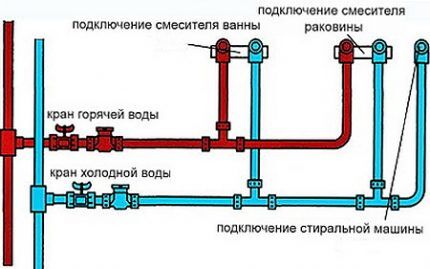
The principle of such a system is very simple both for design and implementation. Water supply is organized in a similar way in almost all apartments built according to standard Soviet designs. One of its significant advantages is the small number of water pipes. Therefore, the costs of creating such a water supply system will be minimal.
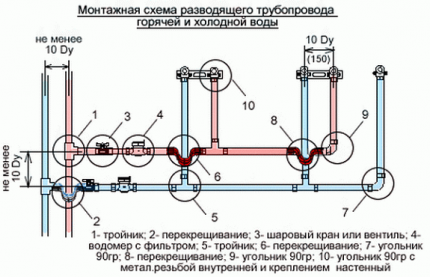
But such a plumbing system is only suitable for the small apartments described above with a small amount of plumbing. The fact is that the longer such a system, the lower the water pressure at the end of the pipeline. Plumbing fixtures connected at the end of the system will receive less water and may not function correctly.
Problems with a consistent water supply system also arise if a faucet or tank breaks down. During repairs or plumbing replacement you will have to shut off the water supply from the supply riser. In small apartments there is one riser (or two hot water supply and hot water supply), here the water is completely shut off.
A serial connection does not allow you to disconnect only one device from the water supply.

Experienced plumbers note a number of other problems associated with servicing tee water supply systems.Connection points are usually hidden under decorative trim and easy access to them is not always available. As a result, when a leak occurs, identifying the problem area becomes difficult.
Very often for plumbing repairs, replacing risers or heated towel rail in the bathroom you have to dismantle false panels, break down walls, etc. And upon completion of the repair work, it may be necessary to re-perform the decorative finishing of the premises. But despite these shortcomings, the tee water supply system is still in demand today.
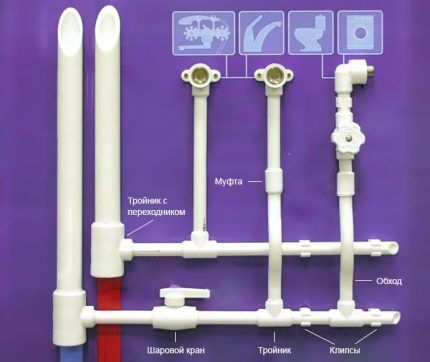
It is considered the optimal solution when designing apartments with a small area. Such housing has a budget price, and the serial connection of plumbing allows you to reduce the cost of its arrangement. At the same time, the pressure in a short-distance water supply system remains quite high.
But in order to reduce the costs not only of creating, but also of operating such a system, you should carefully consider the layout of pipes and tees, ensuring access to them if possible.
Also, do not skimp on plumbing at the expense of the quality of materials. All work must be carried out as best as possible to reduce the likelihood of breakdowns and leaks to a minimum.
Method #2. Beam (collector) version
This wiring diagram is considered the optimal choice for large apartments, as well as where a large number of plumbing fixtures are to be installed. A special feature of this type of wiring is the presence of a collector. Water from the common riser is supplied first to the collector, and then to consumers, i.e. to plumbing fixtures.
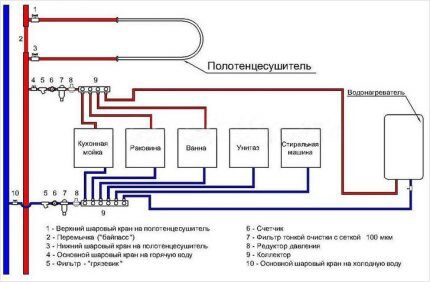
Each consumer is connected separately, and not sequentially, as in the tee system described earlier. One of the main advantages of a collector water supply system is the uniform distribution of water throughout the system.
This means that the number of connected devices and the length of water pipes do not reduce the pressure in the system for one of the consumers.
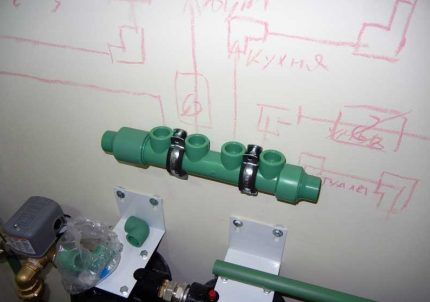
Another advantage of the collector system is the ability, in the event of a breakdown, to disconnect only one plumbing fixture, and not the entire water supply in the apartment, as happens with a series connection. The same circumstance allows you to personalize the characteristics of the plumbing system for each specific device.
To do this, the necessary devices are installed between the collector and the device, for example, filters, gearboxes, etc. On system water pressure can be influenced: the flow of water can be increased or, conversely, reduced, cleared of impurities or saturated with useful substances, etc. The disadvantages of the collector wiring diagram include the high costs of its creation.
You will need significantly more water pipes than when implementing a tee scheme. In addition, such a system is more complex; an inexperienced plumber may encounter problems already at the design stage.
To make a collector connection, you must first select a location for the collector from which the cold water flow will be distributed.
The same device will be needed if hot water supply in the apartment is also provided centrally. The hot water collector is installed separately.
Water pipes are laid between the collectors and the common riser, on which a shut-off valve must be installed. It will allow, if necessary, to completely shut off the supply of hot and/or cold water to the apartment.
Depending on the situation, additional elements may be installed on this section of the water supply, for example, coarse filters or electric taps emergency leakage protection systems. When the collectors are installed, pipes are supplied from them to each plumbing fixture.
Sinks, bathtubs, and shower stalls usually require both hot and cold water supplies. But only cold water needs to be supplied to the toilet cistern or automatic washing machine. If the apartment has water heated towel rail, it is connected to the hot water supply collector.
Additionally, the system may include filters, reducers and other useful devices. Of course, shut-off valves are installed between the collector and the consumer, allowing the water to be shut off only in this specific area, if such a need arises.
On large areas, it sometimes makes sense to combine a collector and tee wiring diagram. In this case, not one consumer is connected to one of the collector branches, but several, connecting them in series with pipes. As a result, this part of the water supply will have the same disadvantages as any tee circuit.
For example, in the event of a breakdown, this part of the highway will have to be completely disconnected. But sometimes combining wiring diagrams can significantly reduce the cost of installing a water supply system.In addition, such a solution may be optimal for individual design of residential premises.
What you need to know about collectors?
According to the principle of operation, a water supply manifold is similar to a tee, only a little more complicated. It has one entrance through which water flows and several outlets for connecting plumbing.
In this case, the dimensions of the inlet pipe are approximately 30% larger than the dimensions water pipes, therefore, the flow of water to the collector occurs faster than its consumption, even if several consumers are activated at the same time.

Thanks to the collector, a large flow is created in the system, which is then simply divided into several smaller flows. The pressure in all parts of the water supply system remains stable, the pressure does not weaken. The throughput of the collector depends on the size of the device and is largely determined by the size of its inlet pipe.
Modern water supply manifolds are made from various materials:
- brass;
- of stainless steel;
- polyethylene;
- polypropylene, etc.
Devices made of polymer materials have fairly high strength characteristics, so they quite successfully compete with their metal counterparts. When choosing a collector, you should also pay attention to the method of their installation. Metal products are usually equipped with traditional threaded connections.

For mounting on plastic or metal-plastic water pipes, which are increasingly used, manifolds are provided with special compression fittings or with fittings for soldering PVC pipes.
There are also devices with a fastening called a eurocone and a combined version, which provides the ability to use several different connection options.
Another important indicator is the number of taps, i.e. outputs for connecting plumbing fixtures. Typically their number varies from two to six.
What to do if you need to connect more consumers to the collector? Everything is very simple; to do this, connect two or three collectors with the required number of taps.

For such a connection, additional pipes are provided on each manifold. They are connected and thus a composite manifold is obtained. Inputs on the collectors that are not needed for connection are closed with a protective plug, otherwise water will simply flow out of the device.
Of course, there are collectors designed for cold and hot water supply. This obvious point should not be forgotten when choosing a suitable device.
Before choosing a collector, you should decide on the type of water pipes. The most common choice today is polymer materials. With them it will be more convenient to install a manifold made of polypropylene or cross-linked polyethylene. These manifolds are usually provided with a suitable fitting connection.
Modern collectors designed for wiring in an apartment according to a parallel circuit are usually already equipped with shut-off valves for each outlet. This is the most preferable solution, since it eliminates the need to install shutoff valves when installing each plumbing fixture.
As a result, costs are lower and installation of the plumbing system will take much less time.
A check valve, the necessary filters and metering devices are usually installed in front of the collector. Some sewers have built-in shut-off valves that allow you to shut off the supply of tap water to your home. If we are talking about a brass manifold, then it is better to choose a model without such taps and install them separately.
A reliable metal manifold can last about half a century, but the service life of cranes is usually limited to a couple of decades. If the built-in taps become damaged, you will have to replace the entire device. But replacing taps installed separately will not affect the device.
Common installation mistakes
Drafting plumbing system, both manifold and tee, is best entrusted to professionals who are familiar with building codes and capable of performing hydraulic calculations. But even the best project will be useless if mistakes are made during its implementation.
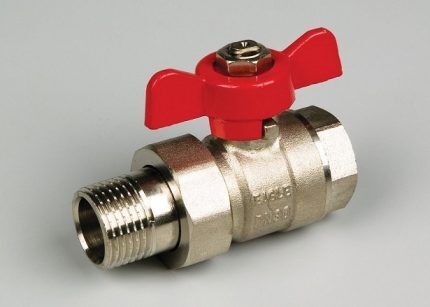
For example, some would-be craftsmen, driven by the thought of unreasonable savings, neglect the requirement to insulate hot water pipes that are laid under the floor or in the thickness of the walls.
As a result, part of the thermal energy is transferred to the materials surrounding the pipe, which deteriorates the quality of the water. In addition, condensation from the surface of pipes without thermal insulation can damage the finishing of the room.
During installation work, experienced craftsmen recommend covering the ends of pipes that have not yet been installed to prevent debris from getting into them. The absence of this protective measure may lead to the fact that immediately after installation the water supply system will have to be thoroughly and for a long time flushed or even repaired.
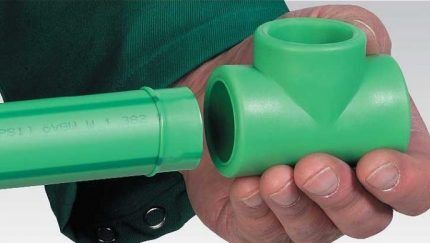
If necessary soldering plastic pipes, all work should be performed in a clean room to avoid contamination. It is also unacceptable to solder pipes that contain even a small amount of moisture. A drop of water or particles of debris at the soldering site can significantly weaken the connection and degrade its quality.
You should not design the water supply system in such a way that all pipes pass through the ceiling through one common hole. This may degrade the performance of the water supply. Professional designers never make such mistakes.
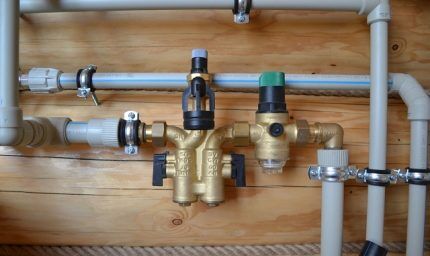
An insufficient amount locking devices can also cause a lot of trouble during installation work. Such fittings must be present in front of each device to which water is supplied, as well as for each riser. If the house has more than one bathroom, you can install a shut-off valve for each of them.
Simultaneously with the water supply system, they usually design and arrange sewerage. It is necessary to ensure that the pipes and risers of individual systems do not overlap each other. This will make maintenance and repair work easier in the future.
Conclusions and useful video on the topic
Video #1. The features of the collector and tee water supply systems are interestingly described in this video:
Video #2. A detailed overview of the collector water supply system is presented in this video:
Video #3. The option with tee wiring can be viewed here:
The correct choice of wiring diagram is an important factor for the normal operation of the plumbing system. But in addition to proper design, you will need to correctly select the necessary materials and correctly perform all installation work. Only if all these conditions are met will the water supply in the apartment last a long time and flawlessly.
Do you want to share your personal experience in altering and repairing water pipes, did you find any flaws in the article, or have questions? We invite you to comment on the material in the block located below the text. We or site visitors will answer.




It’s good that a detailed and accurate plumbing diagram is provided here. I didn’t have one, and this really made the work process difficult.
A very interesting and informative information base. I built the system myself, did it without involving outsiders, and saved a lot for my own budget.
Tell me, please, is it permissible to lay DHW pipes on the ceiling in an apartment? The pipes stretch in the corridor from the entrance to the apartment to the bathroom along the wall and ceiling. Covered with plasterboard.